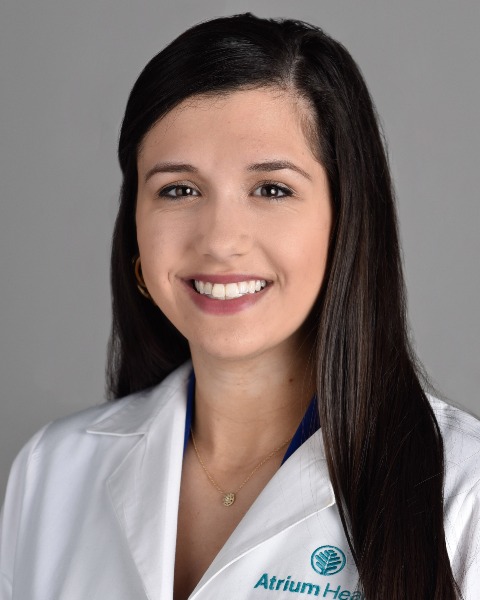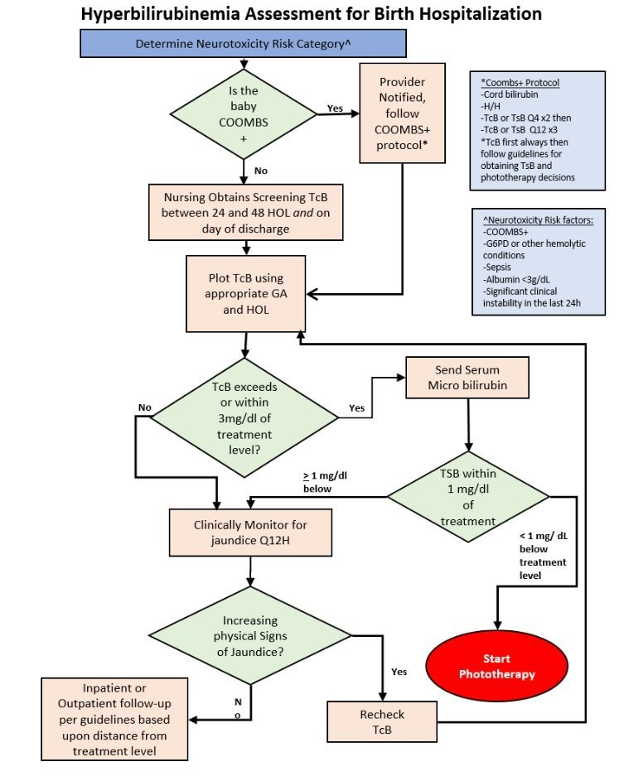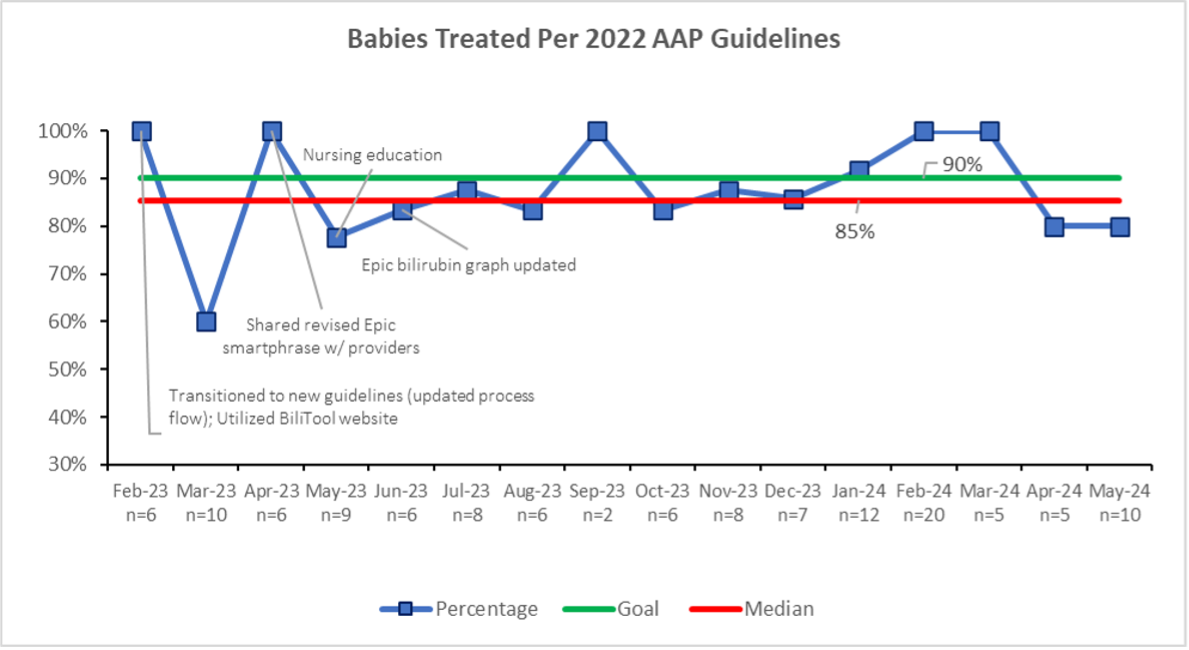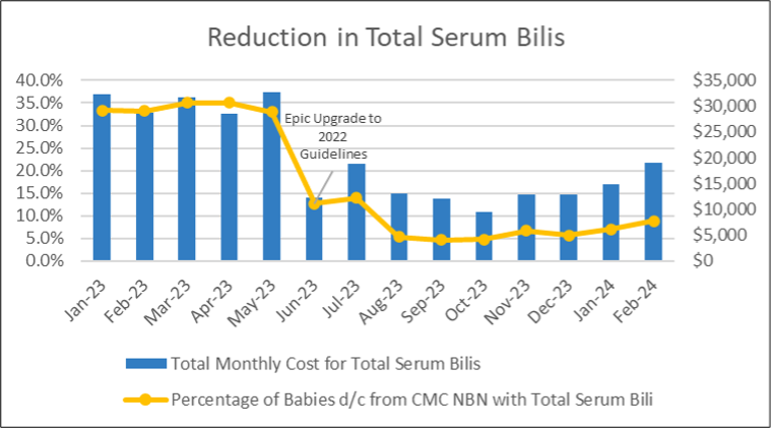Neonatal Quality Improvement 6
Session: Neonatal Quality Improvement 6
531 - Brightening Babies’ Futures: Aligning the Management of Neonatal Hyperbilirubinemia with the 2022 American Academy of Pediatrics Guidelines
Saturday, April 26, 2025
2:30pm - 4:45pm HST
Publication Number: 531.4109
Taylor Allen, Levine Children's Hospital, Charlotte, NC, United States; Ashley Carr, Levine Children's Hospital, Charlotte, NC, United States; Rishi Laroia, Levine Children’s Hospital at Atrium Health, Charlotte, NC, United States; Melissa Schutt, Levine Children's Hospital, Charlotte, NC, United States

Taylor Allen, MD (she/her/hers)
Chief Resident
Levine Children's Hospital
Charlotte, North Carolina, United States
Presenting Author(s)
Background: Hyperbilirubinemia affects up to 80% of neonates and is the leading cause of hospitalization in the first week of life. While usually benign, untreated hyperbilirubinemia can cause serious neurological damage. The American Academy of Pediatrics (AAP) issued management guidelines in 2004 and updated them in Summer 2022. In 2021, we launched a quality improvement initiative to standardize treatment using our evidence-based protocol, updated in 2023 to align with the latest AAP guidelines, aiming to reduce healthcare costs and harm while managing readmission rates.
Objective: Standardize the management of neonatal hyperbilirubinemia for infants in the newborn nursery born at >35 weeks' gestation to consistently follow evidence-based recommendations, as outlined in the 2022 AAP Policy Statement by treating > 80% of neonatal hyperbilirubinemia cases by these guidelines by December 2023. We tracked compliance with initiation and discontinuation of phototherapy per the guidelines.
Design/Methods: We utilized the Model for Improvement framework and team-based interventions to affect positive change in our newborn care. Most notably, standardization of the electronic health record (EHR) reference tools and order sets occurred in June 2023. We reviewed data reports identifying infants who received phototherapy, initiation and discontinuation of phototherapy per protocol and the number of total serum bilirubin (TSB) blood draws taken during their stay. We also tracked readmission rates, defined as readmission for phototherapy within 72 hours of nursery discharge.
Results: We achieved our goal of >80% protocol compliance, reaching a sustainable median of 85% with no change to readmission rates. Additionally, standardization has proven to benefit our patients and clinical team by significantly decreasing number of serum bilirubin draws. When we compared the period before and after the EHR changeover to the new bilirubin nomograms, we saw a 77% decrease in percentage of babies discharged from newborn nursery with at least 1 total serum bilirubin (TSB), and 55% decrease in average monthly cost of TSB (~$16.9K savings per month).
Conclusion(s): While the reduction in total serum bilirubin draws has demonstrated cost savings, it’s also reduced time and effort for nursing and lab staff that can be redirected to other patient care. Standardization of the EHR workflow led to more automatization of the process and less room for human error, leading to improved compliance with the protocol. We also suspect this project has a positive influence on patient and family satisfaction due to less needle sticks.
Hyperbilirubinemia Treatment Algorithm
 Atrium Health hyperbilirubinemia treatment algorithm based upon 2022 AAP guidelines.
Atrium Health hyperbilirubinemia treatment algorithm based upon 2022 AAP guidelines.Protocol Compliance
 Run chart reflecting protocol compliance. PDSA cycles are annotated with sample sizes notated on x axis.
Run chart reflecting protocol compliance. PDSA cycles are annotated with sample sizes notated on x axis.Total Serum Bilirubin Frequency and Cost
 Percentage of infants with at least one serum bilirubin obtained during nursery stay demonstrated with line graph. Blue bar graph displays monthly cost for serum bilirubins for the nursery as a whole.
Percentage of infants with at least one serum bilirubin obtained during nursery stay demonstrated with line graph. Blue bar graph displays monthly cost for serum bilirubins for the nursery as a whole.Hyperbilirubinemia Treatment Algorithm
 Atrium Health hyperbilirubinemia treatment algorithm based upon 2022 AAP guidelines.
Atrium Health hyperbilirubinemia treatment algorithm based upon 2022 AAP guidelines.Protocol Compliance
 Run chart reflecting protocol compliance. PDSA cycles are annotated with sample sizes notated on x axis.
Run chart reflecting protocol compliance. PDSA cycles are annotated with sample sizes notated on x axis.Total Serum Bilirubin Frequency and Cost
 Percentage of infants with at least one serum bilirubin obtained during nursery stay demonstrated with line graph. Blue bar graph displays monthly cost for serum bilirubins for the nursery as a whole.
Percentage of infants with at least one serum bilirubin obtained during nursery stay demonstrated with line graph. Blue bar graph displays monthly cost for serum bilirubins for the nursery as a whole.

